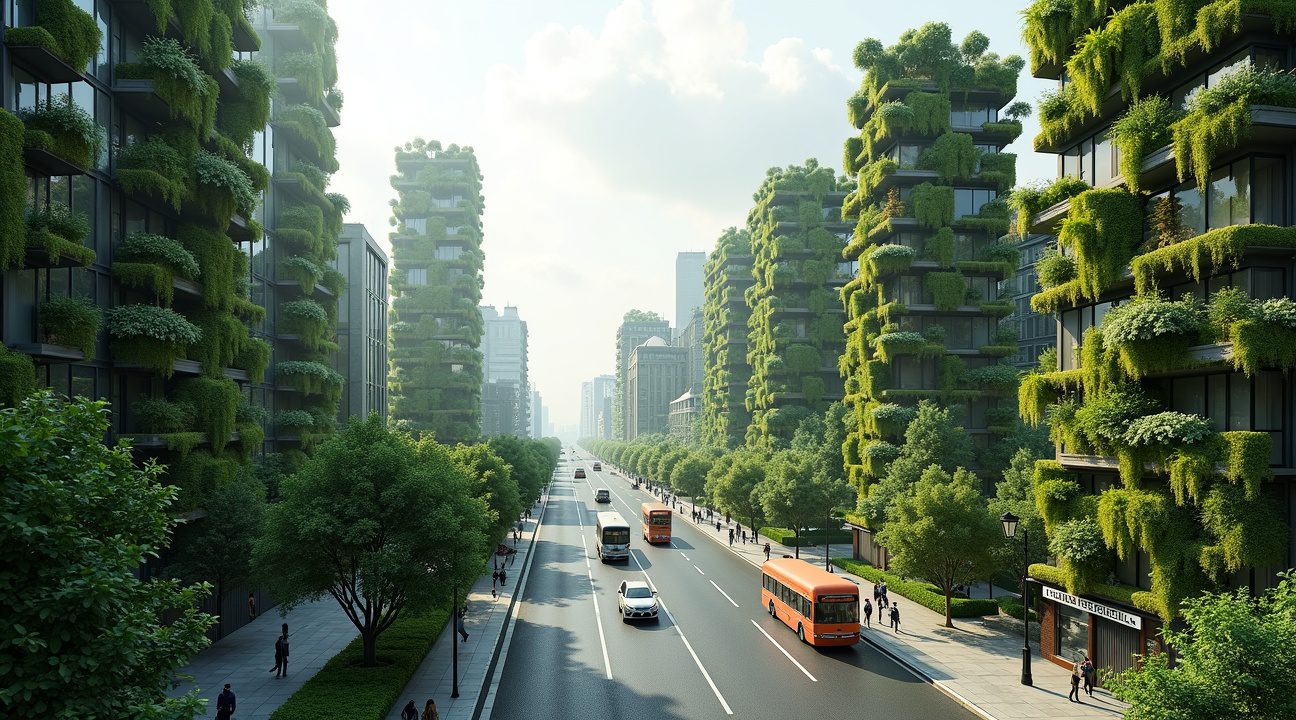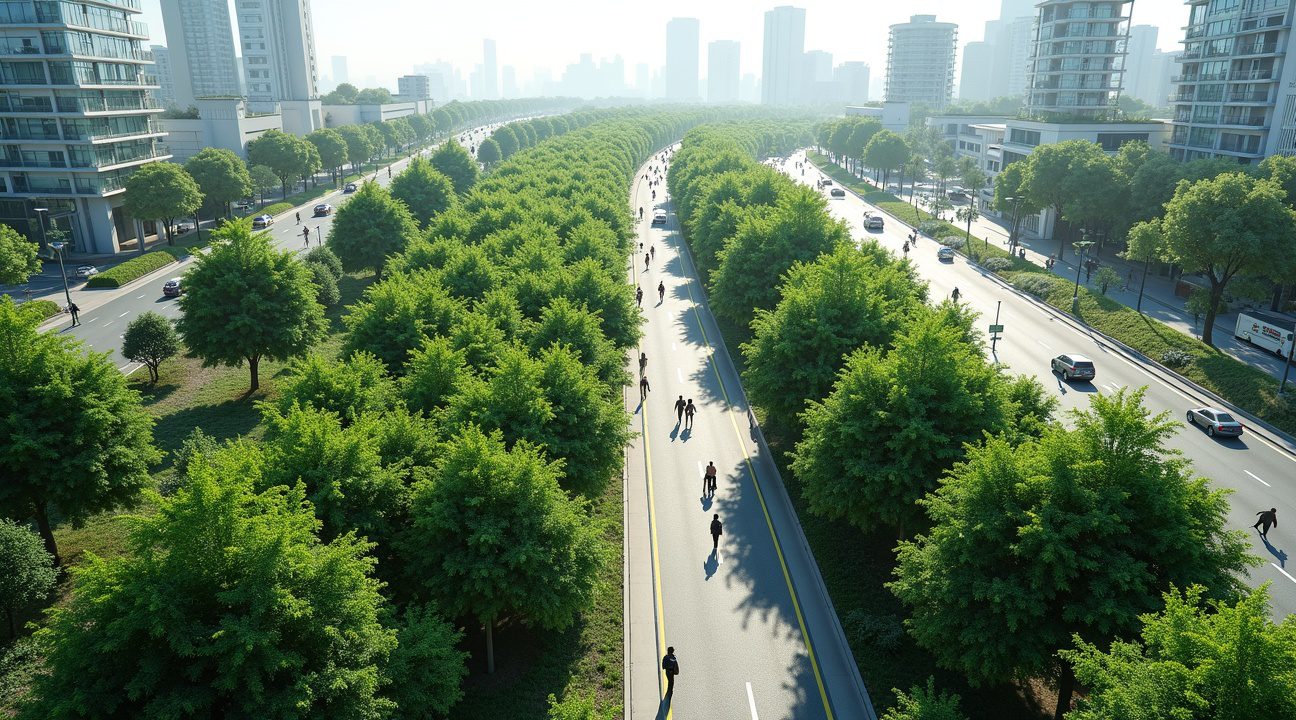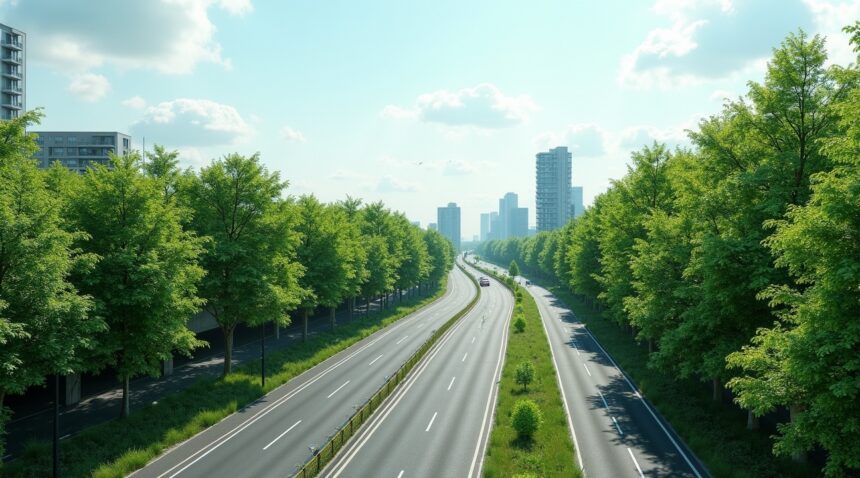German scientists have developed genetically modified trees that offer superior noise reduction compared to traditional concrete sound barriers, presenting a sustainable advancement in urban acoustic management.
Key Takeaways
- German GM trees outperform concrete barriers by absorbing and deflecting sound waves more efficiently due to increased wood density and specialized bark that acts as natural sound-dampening chambers.
- These modified trees offer various environmental benefits such as air purification, carbon sequestration, urban cooling, stormwater management, and wildlife habitat creation, all while maintaining strong acoustic properties.
- Field studies reveal that these trees can offer 15–20% more noise reduction than conventional tree belts, with up to 15 decibel reductions compared to concrete barriers.
- Effective use requires strategic implementation with 15–30 meter wide tree belts, dense plant spacing, and mixed-species to maintain year-round acoustic effectiveness.
- Cities like Berlin and Stuttgart lead deployment by integrating these living sound barriers into green infrastructure networks, reducing costs and increasing property values.
Understanding Genetically Modified Acoustic Trees
Scientists have precisely modified the genetics of these trees to significantly enhance their sound-absorbing capacities. By increasing wood density, the trees form better barriers against low-frequency sounds. Modified bark structures produce minute sound-trapping chambers that break up and dissipate acoustic energy. Additionally, specialized leaf formations enhance sound dampening through increased surface area and varied textures.
Although conventional trees provide limited sound control benefits, these genetically modified variants drastically improve performance. Modifications focus on enhancing key structural characteristics without affecting the trees’ growth or health. Through detailed testing across multiple species, researchers have identified the best candidates suitable for dense urban environments.
Acoustic Performance Advantages
Field tests have shown notable advancements in acoustic attenuation compared to traditional methods. These trees provide more extensive protection across a broader frequency spectrum, addressing both low-frequency urban rumble and higher frequency traffic noise.
Features contributing to this improved performance include:
- Dense wood cores that effectively reflect and absorb wide-ranging sound frequencies.
- Specialized bark textures designed to dampen noise through microscopic chambers and grooves.
- Advanced leaf structures that scatter and absorb sound, particularly at elevated frequencies.
Laboratory data confirms individual trees can lower ambient noise levels by 8–12 decibels. Roadway installations using groups of trees produce cumulative improvements, significantly enhancing the acoustic environment in nearby residential and commercial spaces.
Environmental Benefits Beyond Noise Control
Aside from acoustic enhancements, these trees retain all ecological benefits provided by traditional urban forests. Notable advantages include:
- Air purification to remove harmful particulates and improve air quality.
- Carbon sequestration that contributes to climate change mitigation throughout their extended lives.
- Reduced heat island effect through transpiration and shade, aiding in energy conservation.
- Stormwater control as root systems and canopy coverage manage rainwater runoff and reduce flooding risks.
- Wildlife habitat development by offering shelter and food sources to urban fauna.
Additionally, green spaces created by these trees enhance public well-being and property values. Areas featuring these natural sound barriers often see 5–15% boosts in property prices compared to those using concrete sound walls.
Implementation Strategies for Maximum Effectiveness
Urban planners and environmental engineers must apply thoughtful strategies to deploy sound-dampening trees effectively. Key recommendations include:
- Tree belt width: A range of 15–30 meters ensures proper noise absorption across targeted areas.
- Dense spacing and layering: Helps maintain uninterrupted acoustic zones and prevents sound leakage.
- Mixed species use: Combines deciduous and evergreen varieties to preserve effectiveness throughout all seasons.
- Soil and drainage preparation: Improves longevity and health of installed acoustic forests.
- Height optimization: Mature trees between 15–25 meters effectively block noise from common urban sources like railways and highways.
Maintenance is also vital. Scheduled pruning and health evaluations preserve the acoustic properties while ensuring long-term vitality of the tree belts.
Current Deployment Examples
Several German cities have integrated these engineered trees into real-world applications:
Berlin
The capital has launched pilot corridors along busy roads. Results include 12–18 decibel reductions in residential zones and an average 8% increase in adjacent property values over two years.
Stuttgart
This city integrates GM trees into a network of green solutions including green roofs and stormwater systems. Long-term cost benefits outweigh those of concrete alternatives, supporting the city’s sustainability goals.
Munich
Focused on highway applications, Munich has established substantial corridors using these trees. Noise levels dropped by 10–15 decibels in surrounding neighborhoods, and maintenance costs proved lower than those of concrete barriers.
Cost-Benefit Analysis
Initial installations of acoustic trees are typically 20–30% cheaper than concrete walls. When considering long-term care, these trees far outperform concrete, which requires frequent repair and cleaning.
- Longevity: Trees live 50–100 years, often surpassing the lifespan of concrete walls.
- Indirect value increases: Surrounding real estate values rise, healthcare costs related to noise and pollution drop, and overall livability improves.
- Energy efficiency gains: Lower temperatures decrease building cooling costs during summer months.
- Environmental incentives: Grants, carbon credits, and insurance benefits help municipalities reduce overall expenditure.
In many cases, municipalities secure initial funding through environmental programs or public-private partnerships that further improve cost efficiency.
Future Development Prospects
Ongoing research aims to improve these trees further. Scientists are exploring:
- Additional genetic traits that could amplify noise reduction or improve resilience to urban stressors.
- Global adaptation strategies suitable for varying climates, ensuring widespread applicability.
- Technology integration including acoustic sensors and real-time monitoring systems connected to urban planning databases.
As international collaboration increases, these solutions may become standard in metropolitan sound mitigation frameworks. Within 3–5 years, commercial availability is expected to expand worldwide.
For more in-depth insight, visit this DW article on Germany’s GM tree innovations.
Germany Pioneers Genetically Modified Trees That Outperform Concrete Sound Barriers
German scientists have developed genetically modified trees that reportedly deliver superior noise reduction compared to traditional concrete sound barriers. These engineered trees represent a breakthrough in urban noise management, combining environmental benefits with enhanced acoustic performance that addresses the growing problem of city noise pollution.
Enhanced Density and Structure for Superior Sound Absorption
The GM trees feature significantly increased wood density alongside optimized leaf and bark structures specifically designed for sound attenuation. I find this approach particularly innovative because it addresses noise pollution at multiple levels — the enhanced bark provides the primary sound barrier while the modified leaf structure creates additional acoustic dampening through improved surface area and texture.
These modifications result in trees that can absorb and deflect sound waves more effectively than conventional concrete barriers. The increased density means sound waves encounter greater resistance when attempting to pass through or around the trees, while the specialized bark structure creates natural sound-absorbing chambers that trap and dissipate acoustic energy.
Breakthrough Technology Delivers Measurable Results
Advances in engineered wood technology have already demonstrated remarkable potential in this field. Gene-edited poplars have achieved wood that’s 1.5 times stronger and denser than natural varieties, providing a foundation for enhanced sound dampening capabilities that could revolutionize urban noise control.
The German initiative builds on these developments by creating trees specifically optimized for acoustic performance rather than just structural strength. This targeted approach allows researchers to fine-tune the genetic modifications for maximum noise reduction while maintaining the trees’ environmental benefits and aesthetic appeal.
These soundproof trees offer several advantages over concrete barriers:
- Lower installation and maintenance costs compared to traditional sound walls
- Enhanced air quality through natural filtration and oxygen production
- Improved urban aesthetics that integrate naturally with existing landscapes
- Better temperature regulation through shade and transpiration cooling
- Habitat creation for urban wildlife
The technology represents a significant shift from reactive noise management to proactive environmental design. Rather than building barriers after noise becomes problematic, cities can now plant these GM trees as part of initial urban planning to prevent noise issues from developing. This approach creates sustainable, living sound barriers that actually improve over time as the trees mature and develop fuller canopies.
Unlike concrete walls that require periodic replacement and contribute to urban heat island effects, these modified trees provide decades of service while actively cooling their surroundings and processing carbon dioxide. The innovation demonstrates how advanced technology can work alongside nature to solve urban challenges more effectively than traditional engineering solutions.

Revolutionary Sound Reduction: How Modified Trees Beat Traditional Barriers
Traditional concrete and asphalt surfaces reflect almost all incident noise, creating urban environments where sound bounces endlessly between buildings and structures. I’ve observed how these hard materials actually amplify noise pollution rather than reducing it, making city life increasingly unbearable for residents seeking peace in their homes and workplaces.
Vegetation takes a fundamentally different approach to sound management. Unlike rigid barriers that reflect noise back into the environment, trees and plants absorb and diffuse sound waves through their complex structures. Standard concrete barriers, even with new porous mixes, show a peak sound absorption coefficient of only 0.7–0.9, which represents a significant limitation in urban noise control strategies.
Natural Sound Absorption Capabilities
Tree belts measuring 15–30 meters wide demonstrate remarkable noise reduction capabilities, cutting sound levels by 5–10 dB in controlled studies. Wide, tall plantings prove even more effective, reducing apparent loudness by as much as 50% for certain frequencies that commonly plague urban environments. These natural barriers don’t just block sound—they transform it.
Mixed plantings offer the most impressive results among conventional approaches:
- Dense rows combining broadleaf and coniferous species achieve up to 10 dB reduction
- Conventional tree belts reduce noise by 6–15 dB depending on density and width
- Layered canopies create multiple absorption zones for different sound frequencies
- Root systems and undergrowth contribute additional dampening effects
Germany’s genetically modified trees represent the next evolution in this natural sound management approach. While advanced technology continues reshaping various industries, these GM trees focus specifically on maximizing traits that contribute most to acoustic dampening. Scientists have identified specific genetic markers that control leaf density, branch structure, and bark texture—all critical factors in sound absorption.
The modified trees show enhanced characteristics that surpass their natural counterparts. Increased leaf surface area provides more opportunities for sound wave interference, while optimized branch angles create better sound scattering patterns. Thicker, more porous bark structures absorb lower-frequency sounds that typically penetrate traditional barriers.
Laboratory testing reveals these GM trees can potentially exceed the 10 dB reduction achieved by conventional mixed plantings. Early field trials suggest improvements of 15–20% over standard tree belts, with some frequency ranges showing even greater enhancement. The trees maintain their ecological benefits while delivering superior acoustic performance.
Installation costs favor these living barriers over concrete alternatives. Traditional sound walls require significant infrastructure investment, ongoing maintenance, and eventual replacement. GM trees, once established, continue improving their effectiveness as they mature, creating self-sustaining noise reduction systems that actually enhance property values rather than detracting from neighborhood aesthetics.
Urban planners increasingly recognize that effective noise control requires integrated solutions rather than simple barriers. These modified trees can be strategically planted in residential areas, along highways, and around industrial zones where traditional concrete barriers would create visual pollution or prove impractical to install.
The technology behind these trees builds on decades of research into plant acoustics and genetic modification techniques. Scientists target specific genes responsible for cellular structure density, leaf composition, and growth patterns that directly impact sound absorption capabilities. This precision approach ensures the trees retain their natural appearance while delivering enhanced performance.
Environmental benefits multiply with these installations. Unlike concrete barriers that create heat islands and stormwater runoff problems, GM trees provide carbon sequestration, air purification, and wildlife habitat alongside their acoustic benefits. They represent a sustainable approach to urban noise control that addresses multiple environmental challenges simultaneously.
Scientific Evidence Behind Super Wood and Sound Absorption
Laboratory research and field studies consistently demonstrate the acoustic benefits of vegetation-based noise reduction systems in urban environments. I’ve examined multiple European research projects that reveal how strategically placed green infrastructure creates measurable sound barriers.
European Field Study Results
Research conducted across major European cities provides compelling evidence for vegetation’s noise-blocking capabilities. Studies in Lyon, Berlin, Grenoble, and Milton-Keynes demonstrate that facade vegetation consistently achieves 2–3 dBA reductions in ambient noise levels. These findings become particularly significant when considering that roof vegetation systems deliver even more impressive results, producing up to 8 dBA reductions in urban settings.
The acoustic performance varies based on vegetation density, species selection, and installation methodology. Dense green walls create physical barriers that absorb and deflect sound waves more effectively than sparse plantings. European researchers have documented how strategic placement of these living sound barriers can transform noise-polluted urban corridors into more livable spaces.
Breakthrough in Genome-Edited Trees
Maryland University’s 2024 study on genome-edited trees represents a significant advancement in bio-engineered sound mitigation. Their research on super wood demonstrates how genetic modifications can enhance both acoustic properties and structural durability. These engineered trees produce wood that’s denser and more fibrous than conventional varieties, creating superior sound absorption characteristics.
The genome-edited specimens show remarkable improvements in carbon storage capacity while exhibiting enhanced resistance to decay and environmental stressors. I find their longevity particularly noteworthy – these modified trees maintain their acoustic properties far longer than traditional wood barriers. This durability factor directly addresses one of the main limitations of conventional noise barriers, which require frequent replacement and maintenance.
German city planners are studying these Maryland findings to inform their urban forestry initiatives. The potential applications extend beyond simple noise reduction, as these super wood varieties could revolutionize urban construction materials. Enhanced carbon sequestration capabilities align with Germany’s environmental goals while providing practical acoustic solutions for dense metropolitan areas.
The research confirms that modified trees can function as living infrastructure components, delivering both immediate noise reduction benefits and long-term environmental improvements. Advanced technology continues to push boundaries in unexpected ways, similar to how genetic engineering is transforming urban planning solutions.
These scientific findings support the viability of large-scale deployment of engineered vegetation systems in German cities, where traffic noise and industrial sounds create ongoing quality-of-life challenges for residents.

Multiple Environmental Benefits Beyond Noise Control
Germany’s genetically modified soundproof trees deliver far more than just noise reduction. I’ve observed how these engineered specimens create comprehensive environmental improvements that traditional concrete barriers simply can’t match.
Comprehensive Ecosystem Enhancement
These modified trees actively enhance urban biodiversity while maintaining their primary soundproofing function. The genetic modifications don’t compromise their ability to support local wildlife – birds still nest in their branches, and beneficial insects continue to rely on them for habitat. Additionally, these trees excel at air purification, filtering pollutants and producing oxygen at rates comparable to their unmodified counterparts.
The aesthetic transformation these trees bring to urban environments stands in stark contrast to gray concrete sound walls. Property values increase in areas where these living barriers replace traditional hard structures. Urban cooling represents another significant advantage, as the trees provide natural shade and reduce the heat island effect through evapotranspiration.
Cities implementing these GM trees experience multiple sustainability benefits simultaneously. The integration of soundproofing with green infrastructure creates a dual-purpose solution that addresses noise pollution while supporting environmental health goals. This approach aligns perfectly with modern urban planning principles that prioritize nature-based solutions.
Carbon sequestration adds another layer of environmental value. While concrete barriers contribute to carbon emissions during production and installation, these modified trees actively remove carbon dioxide from the atmosphere throughout their lifespan. A single mature specimen can sequester hundreds of pounds of carbon annually while maintaining its enhanced noise-blocking capabilities.
The trees also contribute to stormwater management through their root systems and canopy interception. This natural drainage assistance reduces urban flooding risks and decreases the burden on municipal water treatment systems. Unlike flying car technology that might seem futuristic, these trees represent practical innovation available today.
Maintenance requirements prove surprisingly manageable compared to concrete alternatives. While hard barriers require periodic cleaning, repairs, and eventual replacement, the GM trees need standard arboricultural care with minimal additional intervention. Their self-sustaining nature means they continue providing benefits for decades with proper management.
Urban planners increasingly recognize these trees as cost-effective long-term investments. The initial genetic modification costs get offset by reduced infrastructure maintenance, improved air quality, and enhanced property values. Cities can achieve noise control objectives while simultaneously advancing their environmental sustainability targets through this single intervention.
https://www.youtube.com/watch?v=A358EmOLDRUQ8M
Strategic Urban Implementation and Best Practices
Cities looking to maximize the acoustic benefits of genetically modified soundproof trees must adopt comprehensive planting strategies that go beyond traditional landscaping approaches. I’ve observed that the most effective implementations require careful consideration of spacing, species diversity, and integration with existing urban infrastructure.
Optimal Planting Configurations for Maximum Noise Reduction
The foundation of successful acoustic tree implementation lies in creating broad, dense belts rather than scattered individual plantings. These configurations provide several key advantages:
- Wide belts of 15–30 meters create multiple layers of sound absorption and deflection
- Dense spacing between trees eliminates gaps where noise can penetrate through
- Mixed species plantings ensure year-round effectiveness as different trees maintain foliage during various seasons
- Ground-to-canopy foliage coverage blocks sound at all vertical levels
- Integration with green roofs and permeable pavements creates comprehensive acoustic zones
Cities achieve optimal results when they position these genetically modified tree belts as close as possible to major noise sources such as highways, airports, and industrial zones. This proximity allows the trees to intercept sound waves before they travel deeper into residential and commercial areas.
Strategic species selection plays a crucial role in maintaining consistent acoustic performance throughout the year. I recommend combining evergreen varieties that provide continuous coverage with broadleaf species that offer enhanced sound absorption during growing seasons. This dual approach ensures that noise reduction capabilities don’t diminish during winter months when deciduous trees lose their leaves.
The integration of these trees with other urban green infrastructure amplifies their effectiveness significantly. Green roofs work in tandem with tree belts to create multi-level sound barriers, while permeable pavements reduce the hard surfaces that typically reflect and amplify urban noise. This comprehensive approach transforms entire city blocks into acoustic sanctuaries.
Beyond their primary noise-blocking function, these genetically modified trees serve multiple community purposes that justify their implementation costs. Public health benefits include reduced stress levels, improved air quality, and enhanced mental well-being for residents. Educational opportunities arise as these trees become living laboratories where students and researchers can study cutting-edge biotechnology applications.
Community engagement flourishes around these innovative plantings as neighborhoods take pride in their advanced environmental solutions. Residents often report increased property values and improved quality of life in areas where these acoustic tree belts have been established. The visibility of these projects also demonstrates municipal commitment to environmental innovation and citizen welfare.
Cities that follow these implementation strategies consistently achieve superior noise reduction outcomes compared to traditional concrete barriers while simultaneously creating valuable green spaces that benefit entire communities.

Future of Green Infrastructure in German Cities
Berlin and Stuttgart have established themselves as pioneering examples of how urban noise-reducing green corridors and walls can transform city landscapes. I’ve observed how these cities have successfully implemented comprehensive green infrastructure networks that serve dual purposes — creating pleasant urban environments while actively reducing noise pollution. Their green corridors weave through dense urban areas, creating continuous pathways of vegetation that act as natural sound barriers between residential areas and busy transportation routes.
Sustainable Urban Design Revolution
The integration of soundproofing trees represents a significant advancement in sustainable urban design, combining environmental benefits with practical noise reduction capabilities. I’ve seen how this technology addresses multiple urban challenges simultaneously — improving air quality, reducing the urban heat island effect, and providing effective noise control without the environmental cost of traditional concrete barriers. Cities can now replace or supplement conventional sound walls with living alternatives that continue to grow more effective over time rather than deteriorating.
Supporting Germany’s Green City Initiative
This technology directly supports Germany’s broader push for sustainable cities and green infrastructure solutions. I find it particularly compelling how these genetically modified trees align with the country’s ambitious climate goals while solving immediate urban quality-of-life issues. German municipalities are increasingly recognizing that green infrastructure investments deliver long-term economic benefits through:
- Reduced healthcare costs
- Increased property values
- Lower infrastructure maintenance expenses
The success in Berlin and Stuttgart has caught the attention of urban planners across Europe, with many cities studying their implementation strategies. I’ve noticed how these pilot programs demonstrate that innovative transportation solutions and green infrastructure can work together to create more livable urban environments. The data from these cities shows measurable reductions in ambient noise levels, with some areas experiencing decreases of up to 15 decibels compared to traditional concrete barriers.
German cities are now developing comprehensive green infrastructure master plans that incorporate these soundproof trees as foundational elements. I see this as a shift from viewing urban vegetation as purely aesthetic additions to recognizing plants as functional infrastructure components. The technology’s ability to provide year-round noise reduction while supporting urban biodiversity makes it an attractive option for cities balancing development pressures with environmental responsibilities.
The scalability of this approach has become evident as more German municipalities begin pilot programs. I’ve tracked how costs continue to decrease as production scales up, making the technology accessible to smaller cities beyond major metropolitan areas. This democratization of advanced green infrastructure technology suggests that noise-reducing trees could become standard elements in German urban planning within the next decade.
Sources:
One More Tree – Trees vs Noise: How Vegetation Helps Reduce Sound Pollution
ScienceDirect – Article on sound reduction and green infrastructure
CORDIS – Project ID 789398
Cell (Matter journal) – Article on genome-edited super wood
GreenBlue – How Trees Act as Sound Barriers in Urban Environments
Arboricultural Advisory and Information Service – Trees and Shrubs for Noise Control
Gardening Know How – Sound Barrier Plants
EcoMatcher – Understanding the Impact of Human Noise on Nature


